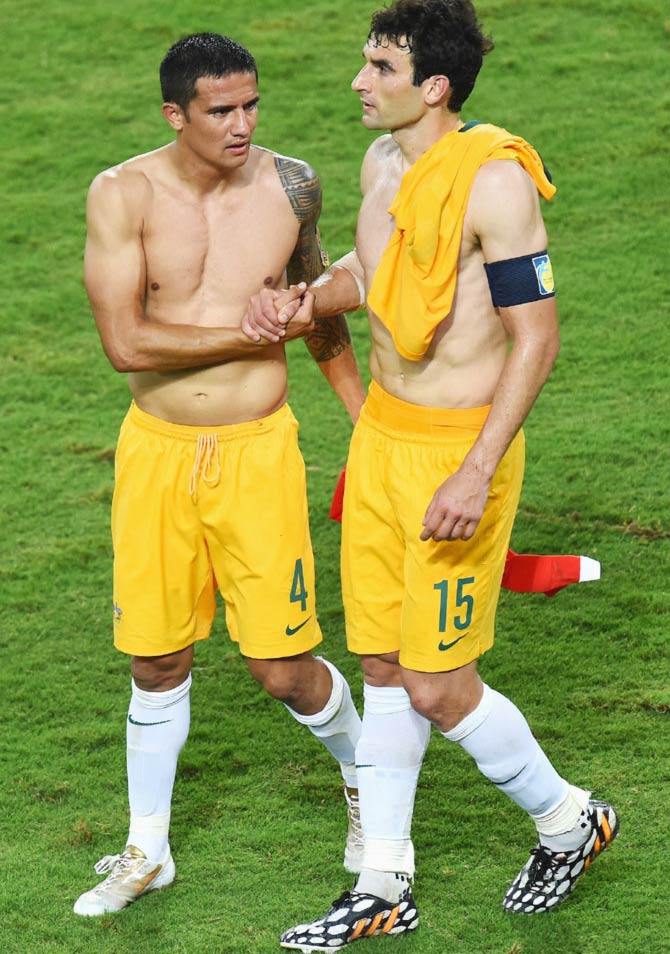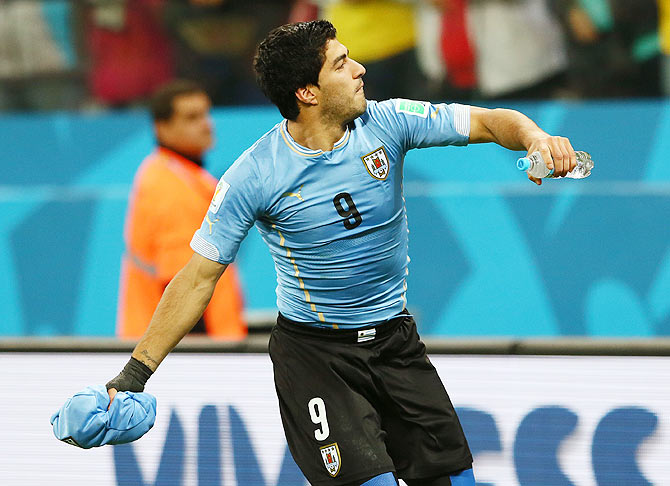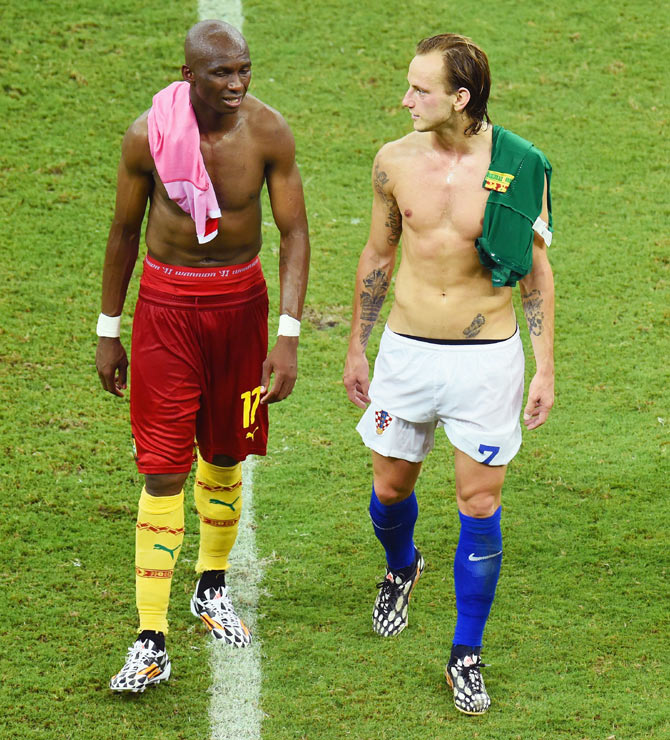Photographs: Stu Forster/Getty Images
It may seem like a strange gift to give someone, but a sweaty shirt exchanged with an opponent at the end of a World Cup game has become both a mark of sporting respect and a valuable collector's item.
- Catch the complete coverage of the football World Cup
But a lot of the garments exchanged are never given pride of place in the recipient's home, and many will end up stuffed into plastic bags and stored in garages and attics until player's career is over and he needs to sell them to raise some money.
When they do so, there are avid collectors all over the world who will pay top dollar for historic match-worn garments.
"A shirt or boots worn by a player whose goal wins a pivotal game, such as Luis Suarez against England, or during a moment of pure genius, like Tim Cahill against the Netherlands, would be highly sought-after," Irish collector Barry Rojack told Reuters.
Rojack has acquired several classic pieces of Ireland's World Cup history. Many are unwashed and still have grass stains on them.
- ...
'A good World Cup shirt might set you back anything from 400 euros to 1,000 or 2,000 euros'
Image: Luis Suarez of Uruguay throws a shirt into the crowd after defeating EnglandPhotographs: Kevin C. Cox/Getty Images
Among them is a shirt issued to Ray Houghton for the famous 1-0 victory over Italy in 1994 in which he scored the winning goal and Damien Duff's top from the 2002 World Cup round of 16 when Ireland lost to Spain on penalties in 2002.
- Catch the complete coverage of the football World Cup
Duff swapped it with new Barcelona manager Luis Enrique, who gave it to Rojack.
As to the value of a garment worn in a World Cup, Rojack says it can be hard to estimate, saying: "Generally you can't properly ascribe a long-term value to a World Cup shirt until the tournament is over.
"For instance, Suarez's shirt from the England game is worth a lot today, but in a month's time that could go up or down depending on what happens with in the rest of the tournament."
Such items are neither easy nor cheap to get hold of, even for experienced collectors.
"Roughly speaking, a good World Cup shirt might set you back anything from 400 euros ($540) to 1,000 or 2,000 euros. That assumes you can get one, and are satisfied the provenance is good."
For collectors, the biggest problem in the market is establishing that what they are being offered is the genuine article, and not a forgery.
'Generally the shirts players wear are significantly different to ones you buy in the shops'
Image: Bosnia's Edin Dzeko (left), Asmir Begovic and Nigeria's Peter Odemwingie (centre) exchange jerseys at the end of their matchPhotographs: Ueslei Marcelino/Reuters
"Sourcing shirts is not easy. The best way is through the player, their agent or family, or through an administrator within the relevant football association," says Rojack.
- Catch the complete coverage of the football World Cup
The collector adds that online auctions can be a good resource, but that "there are an awful lot of fakes available online."
"Generally the shirts players wear are significantly different to ones you buy in the shops," the 35-year-old said.
"It goes from things like larger sponsor's and player's names and numbers to less obvious things like the type of material used, the country of manufacture, the embroidery used on badges."
"One common fake you see is a replica shirt which has been 'dressed up' to look like a match shirt," he says, adding that he pores over photographs and match videos to establish the authenticity of prospective purchases before buying.
"Think about a classic Renaissance painting -- not only is it possible to fake them, many genuine paintings have been incorrectly ascribed as fakes and vice versa," he says.
"So trust and research can only reduce risk, not eliminate it."
Fellow enthusiasts all over the globe buy, sell and swap shirts of historic significance
Image: Stephane Mbia of Cameroon and Ivan Rakitic of Croatia walk off the field after Croatia's 4-0 winPhotographs: Stu Forster/Getty Images
The Irish collector is part of an informal network of fellow enthusiasts all over the globe that buy, sell and swap shirts of historic significance, and it surprises people that many collectors are uninterested in signed replica shirts that are readily available.
- Catch the complete coverage of the football World Cup
"Take Pele. He has probably signed half a million replica Brazil shirts in his lifetime, maybe more. But he probably wore less than 200 in games, so hardcore collectors like me don't generally collect signed replicas, only match-worn shirts."
"Mind you, I do have one of those ubiquitous signed Pele shirts but the one I have is blue, which is much rarer than the yellow ones!"
With thousands of items already in his collection, Rojack says he has no plans to stop collecting or to sell it off, and he may yet add some shirts from Brazil 2014 if the chance presents itself.
And a whole new area of collecting may be opening up with Croatia's Ivan Rakitic and Cameroon's Stephane M’Bia deciding to swap shorts after a World Cup Group A match on Wednesday.






Comment
article